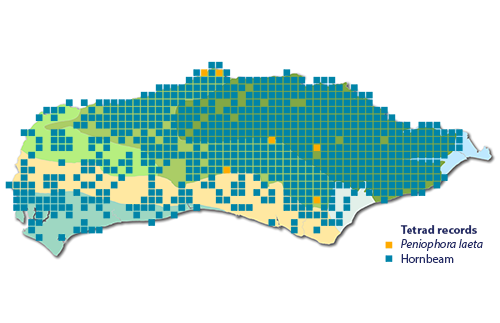

web.jpg)
Peniophora laeta, a collection from Worth Park, Crawley
Photo: Nick Aplin
web.jpg)
Peniophora laeta, detail showing hyphal ‘pegs’ peeling away the outer bark
Photo: Nick Aplin
web.jpg)
Peniophora laeta, sketch of microscopic anatomy. Top: Basidiospores, Bottom hymenium with crystal-encrusted metuloid cystidia, gloeocystidia containing oil droplets and basidia with four sterigmata
Sketch: Nick Aplin

Tetrad distribution of records of Peniophora laeta and Hornbeam Carpinus betulus in Sussex
Source: SxBRC
Peniophora laeta is a distinctive looking fungus with quite a lot going on. Surprising then, that it remains so seldom recorded…
Like many other members of the genus Peniophora, it likes to live up off the ground, often on branches still attached to trees. British records strongly suggest that the species is host-specific here, only living on Hornbeam Carpinus betulus branches, where it gets all up in the tree’s cambium before slowly prizing off the outer bark (from the inside!) with its creepy hyphal ‘fingers’. The plan is to get the bark out of the way so that it can have a party, flinging its spores all around to land on neighbouring branches.
Peniophora laeta can be found throughout the year, but in dry weather it looks a bit dull, shrivelled and inconspicuous. Things are different after a nice bit of rain however, when this species is more active (is that the right word for something that barely moves?) and easier to find. Next time you’re sheltering from the rain under a Hornbeam in your local park, why don’t you take a look above you - I bet you’ll find it!
Under the microscope P. laeta has gently curved, cylindrical spores, and several types of hymenial cells including those filled with oil drops and others reminding me of those science toy Christmas trees that grow crystals. What these cells actually do, nobody really knows. Probably they’re something to do with moisture control (it can dry up there in the Hornbeam canopy!). Here are some other difficult questions that I can’t answer about this species:
• Since there are so many Hornbeam trees in Sussex, why are they so few Peniophora laeta records?
• Why hasn’t this species got a common name? Shall we make one up? Hornbeam Peeler is my favourite…
Observations of this lovely species can be inputted to iRecord for verification by your friendly County Basidiomycete Recorder, Martin Allison.
Nick Aplin (your friendly County Ascomycete Recorder)
Every month it is our aim to highlight a species that is “in-season” and, although not necessarily rare or difficult to identify, has been highlighted by our local recording groups as being somewhat under-recorded and for which new records would therefore be welcomed.
If you or your recording group are aware of species such as this then please contact Bob Foreman.